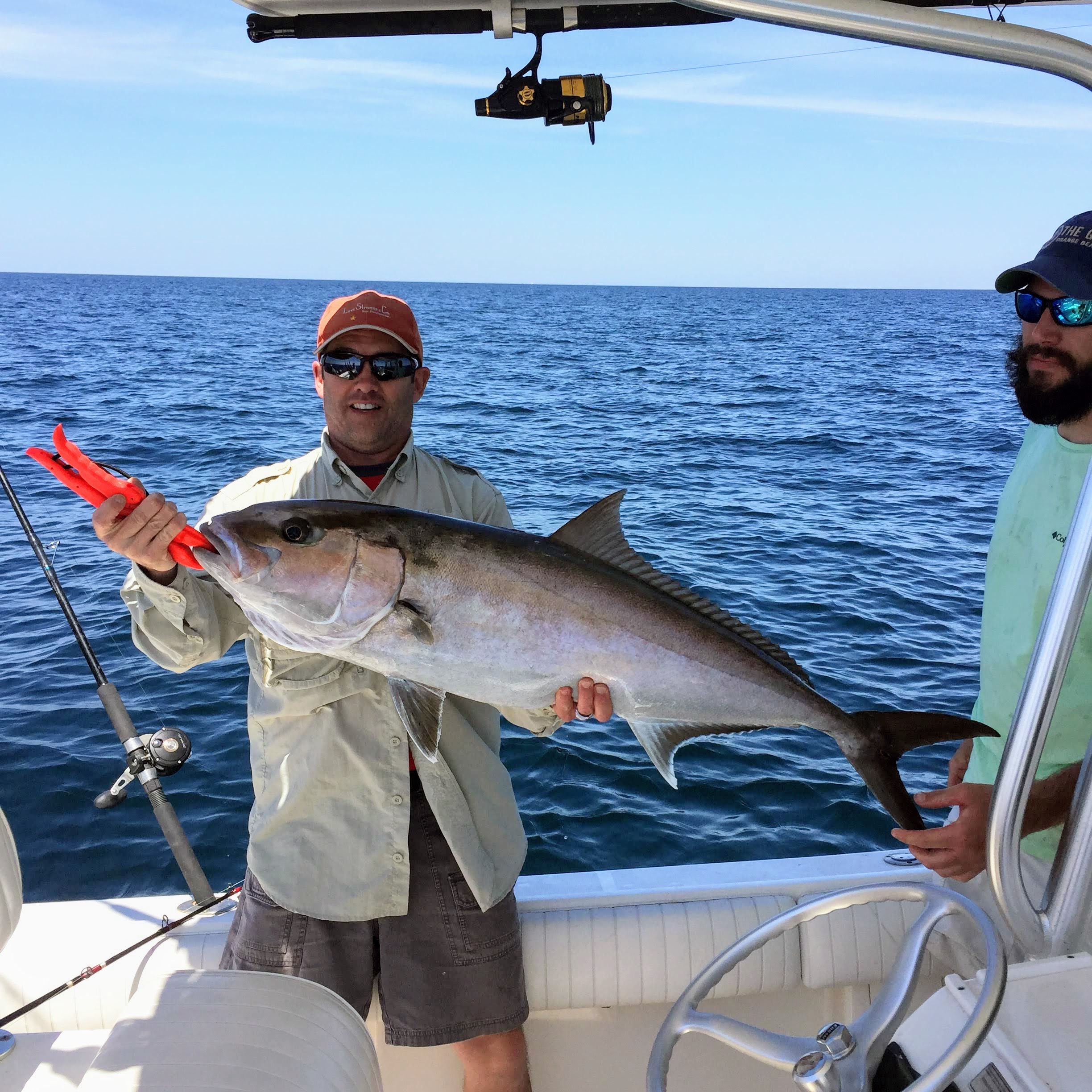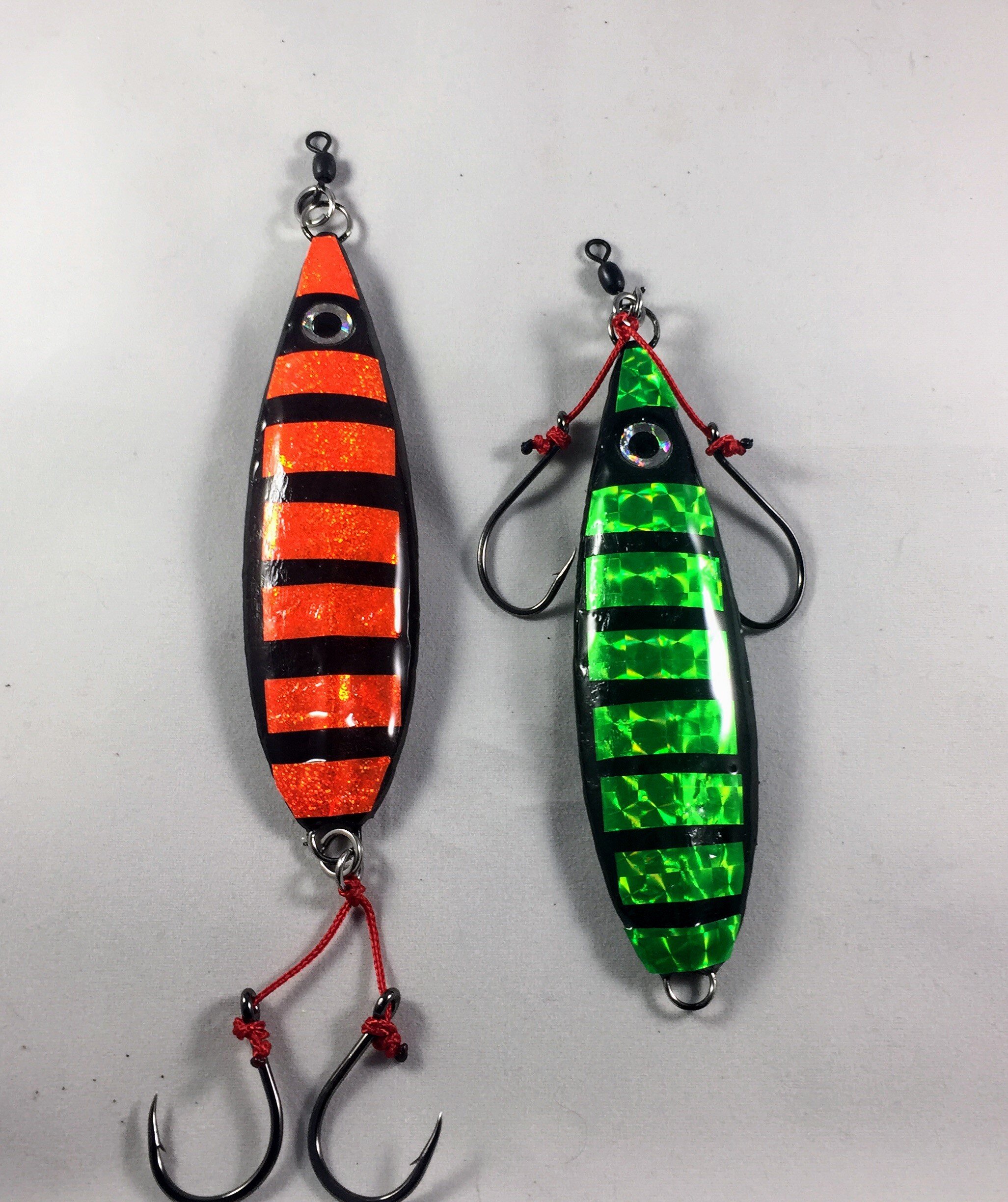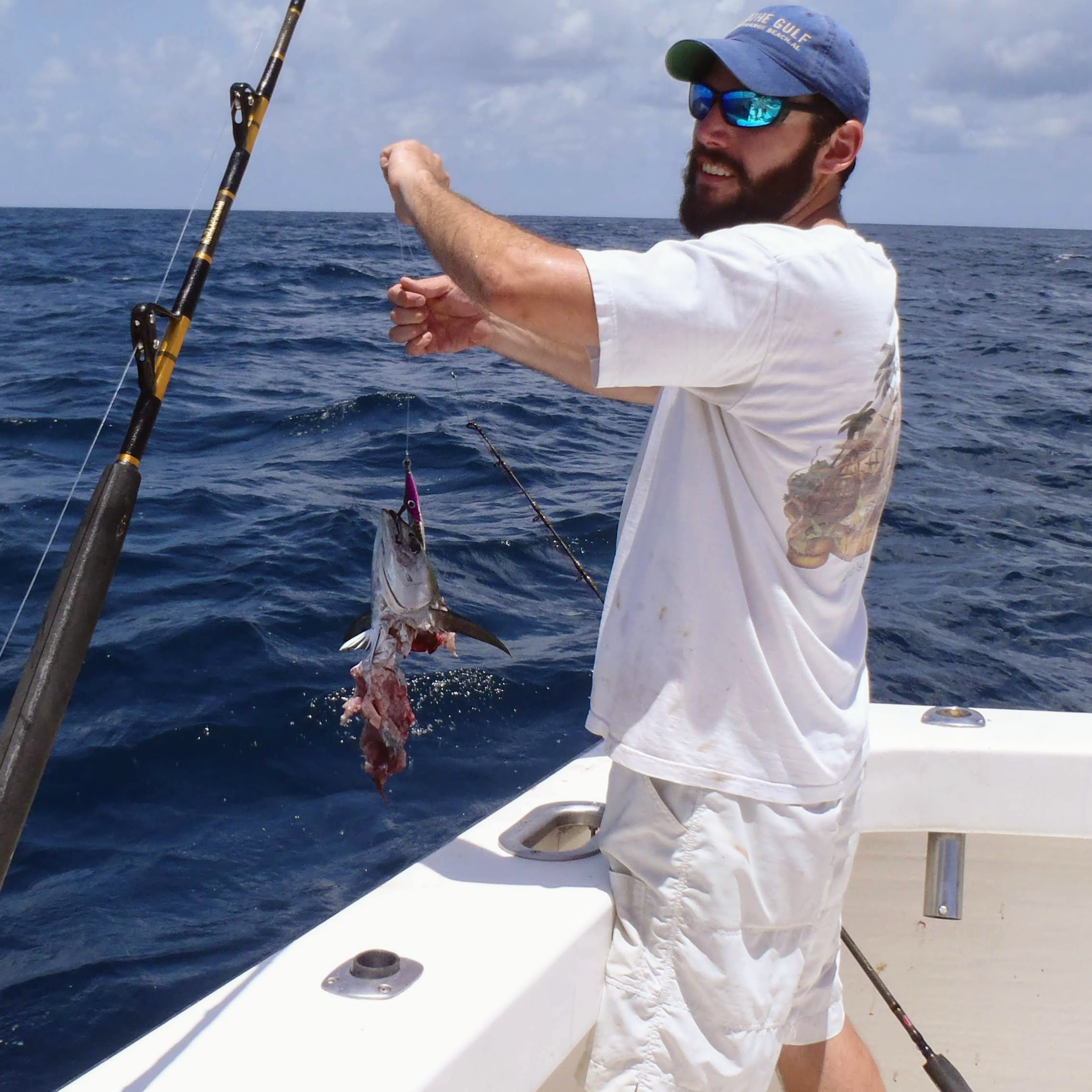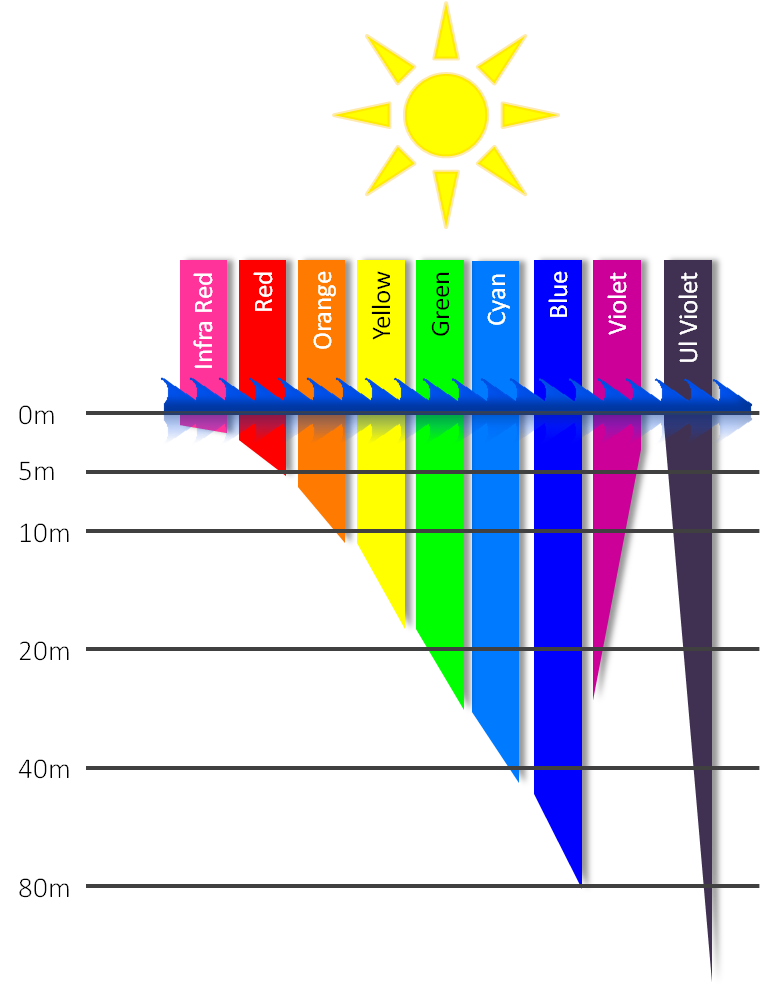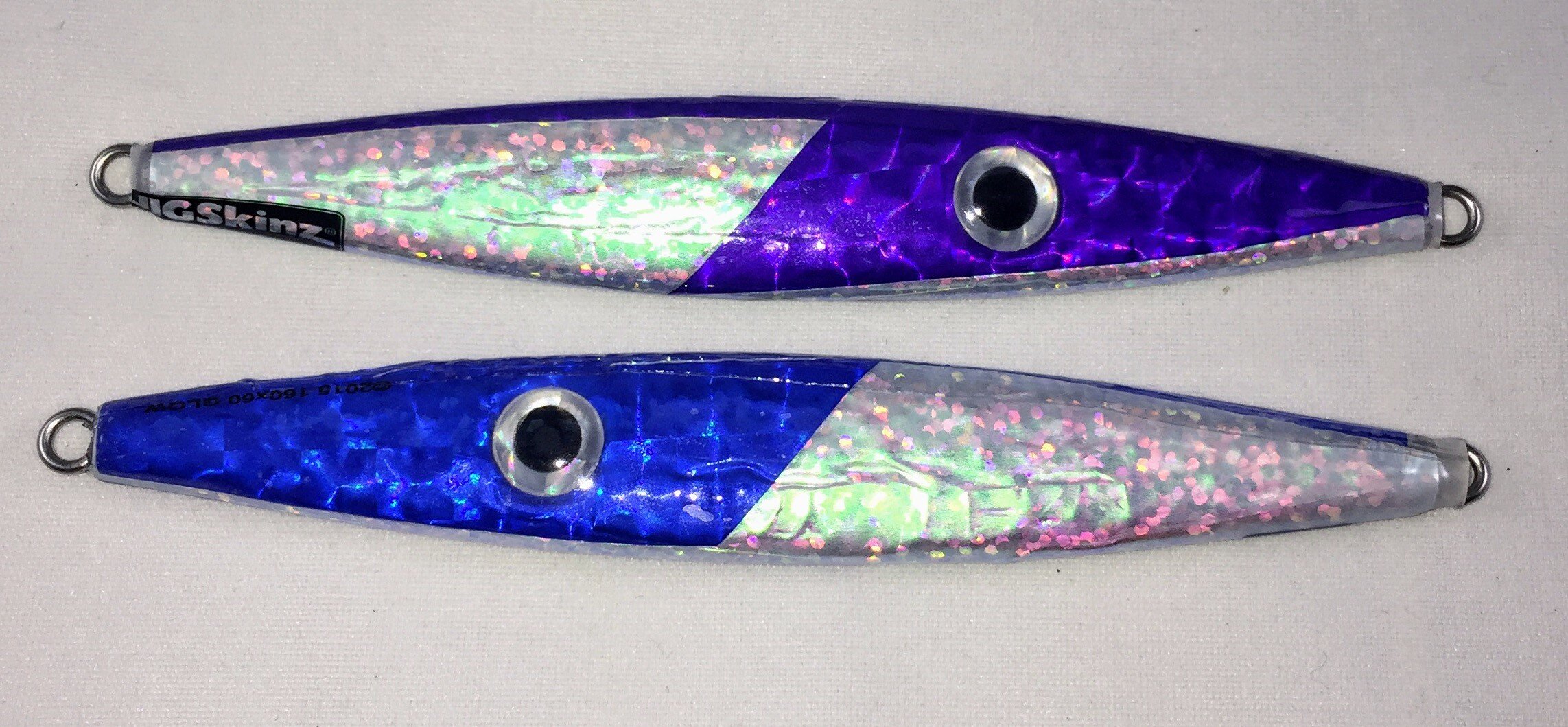VERTICAL JIGGING TIPS AND TECHNIQUES
Please See the video and article links at the bottom of this page for additional information and expertise from others, including the experts. Please visit us also on Instagram and Facebook.
The exciting aspect of saltwater fishing over structure or visible bait schools is that you never know what you will hook/catch, from tiny baitfish 1/2 the size of your lure to monsters that break off and you never see. I will never fully understand why you can have a fish finder screen full of fish and nothing bites, regardless of the bait you offer. Come back in 2-4 hours and those same fish may bite. As we know there are many variables including moon phases, tidal/current change, barometric pressure, boat position/drift, and of course bait/ presentation. Fishing and fishing tackle is a multi-billion dollar industry and all of us fishermen are hooked. It will still always be fishing and not necessarily catching. I don’t profess that I am an expert, or that my jigs are the best available. There are numerous other options. Check the About our Jigs page for more information about what makes us unique. I am also well aware, at the right time/place you can drop any piece of metal, bare lead, butter knife, bare hook, etc. and catch fish. I will continue to periodically update the links and videos below that I have found informative, describing some of the various techniques of high-speed jigging and slow pitch jigging. There is also the West Coast style of “surface irons”, and different ways to rig jigs for monster bluefin tuna.
The advantage to jigging is that you can cover the entire water column from top to bottom (obviously depending on water depth and line capacity), and you are actively working to fool the fish rather than just waiting for the bite. The fish bite is triggered by the appearance of either an escaping baitfish (or squid), an injured baitfish, or both. You can vary the jig shape, size, color, action/presentation, depth, and weight versus current, depending on the situation and target species; and you don’t get slimy stinky hands! If you haven’t already, you should add jigging to your arsenal.
Since my initial writing here in 2018 Slow Pitch jigging has taken a bit to become established in the US, but is now booming. There are now a gazillion “slow pitch” jigs available online, and the in store options are gradually increasing. In general “Slow Pitch Jigs” are more center weighted/flatter jigs with variable action on the fall. There are now numerous modifications with edge angles and end scoops to vary the fall pattern. The general concept is a wounded baitfish, squid or some other tasty creature on the fall. (Contrast standard and especially speed jigging that mimics an escaping bait). The availability of quality rod choices and pricing with competition has also improved with time. As competition increases the prices will continue to decline.Do your own research regarding line choice and rod choice. There are several new and informative jigging groups on Facebook including Artificial Only, Jigs Only (more West Coast), Gulf Coast Slow Jigging, Salty Jiggers, Slow Pitch Jigging, Slow Jigging Group, Reel Jiggers, High-Pitch & Slow-Pitch Jigger Community, and Florida Deep Drop Fishing. The “experts” on those forums will give you plenty of opinions on rod choice, blank choice, reel choice, etc. Do your homework, but ideally visit your local trusted tackle shop together the equipment and feel that works for you.Invest in a quality reel with beefy gears. You will destroy your lighter reels with high-speed technique and heavy jigs.
I personally like spinning reels for standard casting and jigging. I have 2 Penn Spinfisher SSV 6500 LL and 1 6500 Penn Slammer III. I personally prefer a longer rod, usually 7ft, with a long foregrip to help fight larger fish. I have 2 inexpensive Tsunami Trophy jigging rods, (actually quite pleased with these) and one older stiffer Star rod for standard “speed jigging”. This setup offers versatility for other applications including live or cut bait and flat line. I have a Truth LG (now Seigler) conventional reel on a Calstar 700M custom build, also an Accurate Boss 400 on a custom Batson Revelation jig rod; I built both with a long foregrip, my preference. The longer rod helps when those big king mackerel continuously circle the boat. I sacrifice some rod sensitivity for practicality. Yes, I also use Slow Pitch technique with Standard rods.
I do think the action with slow pitch jigs is better with a split ring and barrel swivel on top rather than simply tying to the jig eyelet; unfortunately I have lost a couple of quality fish when the barrel swivel pulled through the split ring-losing both fish and jig. I now more commonly use the barrel swivel well above the jig, and a loop knot to the jig.
I understand the concept of using lighter double assist hooks on top and bottom, distributing the hook stress. Double hook ups are also fairly common. With our restricted seasons and catch limits I still personally use double hooks only on top or bottom (not both) to avoid excess injury to a released fish. I have had more success with rear assist hooks.
(Shown with VMC 5/0 and Owner 3/0) I currently offer the thicker VMC 3/0 and 5/0 hooks. Other good options include Shout, Gamakatsu 510, and VMC 7269
I personally use 50lb braid for most of my standard jigging with a 10-20 ft mono topshot, usually 50lb, using the Collins (RP) knot or another variation of the Alberto knot. It is much easier to tie than the FG or PR knot.
I rarely use fast “speed jigging”retrieve techniques unless I am specifically targeting amberjacks; Then I try the most ridiculous erratic retrieve possible; the wobble jigs offer added action/success.
I like to use a barrel swivel with a plastic bead above it on the mainline, before the leader. Without the bead I almost always reel the swivel through the front eyelet on the retrieve. (see photo) I think that helps protect the eyelet, and I get frustrated having to pull the swivel back through the first 2-3 eyelets to drop again. The swivel helps with line twist, especially with a foul hooked fish. I most frequently use 4-6ft of 50lb fluoro leader from the swivel to the jig. I like the Offshore Angler 50 lb fluoro from Bass Pro, as shown below. I may swap to 80lb leader if continuously pulled into the wreck and abrasion cutoff, and especially for amberjack.
CHUM: Chumming can frequently turn a dead or mediocre bite into a frenzy. I bought the original ChumChurn several years ago and it has been well worth the $150 investment. The company is out of business but there are available variants, and YouTube video instructions to make your own. Get up current from your spot and churn, or chop and drop whatever bait you have. Toss some live bait if you have a surplus. You obviously then want to jig higher in the water column as the fish will literally rise to the occasion. (Put out a flat line also on the surface with cut or live bait)
Wire Leader: I had one tuna trip where they wouldn’t bite a snap swivel attached to the jig eyelet while everyone else was catching. I removed it with subsequent success, and I now always tie directly to the jig, or the solid ring of the assist hook while initially targeting tuna. For repeated cutoffs at the assist cord consider using a trailer hook or a wire assist hook. In my reading fish probably consider a wire assist hook as part of the bait. Opinions vary especially about tuna and a wire leader above the jig. Some say never use wire, some say OK at night but not daylight. I use a wire leader, about 8 inches, only if necessary after repeated cutoffs. King mackerel, sharks, barracuda, wahoo and all toothy critters will add to your expense. Texas Tackle makes the best split ring pliers that I have used. I recommend size large or XL. I have also read good reviews on Toit split ring pliers.
I have given several jigs for trial to a charter first mate rigged with 60 lb nylon coated wire. He has had great success and does not feel that wire has been a deterrent for most species including blackfin tuna. (it will obviously vary). I have had good success with AFW 60 lb black nylon coated wire and #4 crimp.Leave about 1/2 inch tag, crimp it, then do 2-3 tight barrel wraps around the main wire. Heat the crimp with a lighter until the nylon wraps melt together. (see photo above) So far I have not seen a crimp failure. The split ring lets you fairly quickly change jigs. So have wire available if you need to!
Jig weight vs water depth: Dedicated jigging started in Japan, so many manufacturers use the metric system. Most individuals recommend a jig weight of about 100g (3.53oz) per 100 ft depth (30.48 meters). (some say 1 gram/foot) See chart below. So basically up to 3.5oz at 100ft 6oz (170 g) at 200ft. and so on. Jig choice will also depend on your desired target species/depth. Grouper stay near structure. Amberjack schools are frequently in the mid depths of the water column. Larger red snapper, especially with chumming, are more commonly caught in the upper water column. I personally suggest that you start with a smaller jig weight depending on your target species and increase from there depending on the conditions.
Benny Ortiz, a Slow Pitch guru, recommends starting at 1.5 grams/100 ft since these baits sink a bit slower. (I think start less, but he fishes a lot more than me)
On the Alabama Gulf Coast the water is relatively shallow, with a very gradual decline. I have to run about 40 miles to reach 200ft depth (fortunately only a few more miles to reach 600ft), so I spend much more fishing time in 100ft or less. I therefore rarely use more than a 6oz jig. My personal favorite is my 3oz because of the versatility in casting or jigging. I keep one rigged on a spinning outfit and cast to anything that floats, weedlines, and surface bait schools. I have caught fish with a steady retrieve, erratic retrieve, and even trolling at about 8 mph. When fishing over structure/reefs I use the heavier jigs when necessary to initially reach the bottom, then various retrieve techniques working back up to the top. Other than jack species that love a fast retrieve, I get the most bites on all of my jigs as the jig is falling. I usually start with a High Pitch/Long Fall presentation. Part of what makes slow pitch fun is the sensitivity of the equipment lets you feel more of those bites on the fall.
Choosing Jig Color: Many individuals swear by one color only, or a realistic finish only. Many others say that color doesn’t matter. Baitfish obviously reflect light, they have varied coloration that changes, and some have UV (biofluorescent) and glow in the dark (bioluminescent) properties. Squid also glow. I therefore offer several varieties of these properties as well as realistic patterns. If you view the chart and watch the video series below you see that only certain colors are still visible in deeper water; Visibility worsens with cloud cover, murky water and wave action. There is reportedly no visible color at 300ft. UV (fluorescent) properties/colors are said to be better in low light conditions (e.g. murky water, cloudy days) compared to brighter light; UV wave penetration is much deeper (see chart) so fluorescent colors can work at greater depth.
In theory the realistic appearance should be the least visible in deep water, but the JigSkinz and now NLO fishing teams continue to prove their effectiveness in deep water. I was happy to see them offer some glow options as well. (I would like to think that I was one of the first to modify the JigSkinz with glow paint and later SuperGlow.) In my opinion fluorescent properties are important at most depths and glow properties are useful at all depths, even in daylight. My favorite jig color is pink; that makes no scientific sense but I frequently use fluorescent pink or add some component of glow.
I stated here in December 2020 that I was a bit surprised at the frequent use of “Zebra Stripes” by many reputable manufacturers including the above from Daiwa. It has now become common especially in the slow pitch jigs. This is obviously far from a realistic appearance. The lighter bands usually glow in the dark, and the color bands and/or edges are frequently fluorescent. I guess I should not have been surprised as these properties add to visibility. I am a big fan of fluorescent and glow and have promoted those properties in my jig design from the beginning. I offer Flash series with amazing light reflection and color shift, Realistic series using JigSkinz, and Glow series. I have a few products with X-TRA Glow paint and also SuperGlow tape that will glow up to several hours after light charging. The fluorescent properties are intermingled in the Flash and Glow series, and I also offer glow options in the Realistic series. Please see my About our Jigs page for additional info.
One of my versions. 8oz Knife Jig with Fluorescent and SuperGlow
JigSkinz: I am a big fan of their products and I encourage you to try them. There are several patterns (flavors) available including Clear Glow. I offer a few flavors in a 2-pack. There are several instructional videos online including JigSkinz.com. I use size small on almost all of my lures and jigs. Measure the total length and largest diameter of your jigs, and choose the appropriate size. With lures be sure to include the hook eyelets in your width measurement. For most of your lures and jigs you will fold the skinz perpendicular with the label on top. Trim to adjust the eye position and desired length. I use a clothespin when possible to maintain the proper orientation and position. Same with the Clear Glow and UV covers, orient the JigSkinz lettering along one edge of the jig; this will help avoid a visible seam through the eyes of your jig. I use pipe cleaners or long twist ties to avoid burned fingers. I also dip horizontally at an angle starting at one end, then submerge the remainder for about 5 seconds. This will help avoid visible air pockets. Remove the clothespin and dip again if there are any visible seams.
DO NOT use Pyrex to boil your water! I liked the visibilty through the glass but I have now had 2 of the rectangular dishes literally explode while boiling water. Awful mess and lesson learned.
After with Clear Glow
JigSkinz clear glow offers a uniform smooth finish with a subtle glow for several minutes. My Ultra-Glow paint products offer a bit more intense glow, again for several minutes. The glow finish will vary depending on how the paint lays/dries. The SuperGlow is rated to glow up to 24 hrs with a 10 minute light charge. A UV flashlight is the best and fastest way to charge any glow product.(see page bottom-Realistic with SuperGlow)
I have added several DIY components in the Hooks section including assist cord, split and solid rings, VMC 7269 Assist Hooks, and heat shrink. Scan the video links below for additional How To info.
There are numerous reputable jig and tackle manufacturers available. I offer unique handcrafted quality products, Made in the USA, at a reasonable price. I may only offer 1-2 of each unique item, but can certainly make more. Please email me with questions or suggestions.
If I can help you catch fish I will be delighted. If you catch fish on any of my products I will be honored. Best wishes and good luck!
Check out the Shop page>All Products, New Products, or any of the individual categories. Please also check the Sale Items page for ongoing discounts up to 50% or more off. Flat rate shipping in the continental US. (Unfortunately shipping costs continue to increase).
The Sale items are frequently unused cosmetic epoxy defects, refinished jigs, or other items that I do not need. There are explanations in the product description for each item. I have also marked down several items in the All Products page.
I am obviously Gulf Coast but I would love feedback from you West Coast and East Coast fishermen about your species preferences, and also the inshore freshwater folks e.g striped bass, lake trout!
Please send me fish photos caught with any of my products. Email me with questions and suggestions.
Bob Bradley
Owner and Founder
LINKS (consider opening in a new window so that you can return here)
https://apple.news/A6YmeE0clR5SHfeSFO92Ouw
Very informative article discussing numerous styles of jigging
https://www.youtube.com/watch?v=Yby-i0UukjA
Excellent overview of jigging techniques from Florida Sportsman Magazine
https://www.saltwatersportsman.com/vertical-jig-fishing/
Excellent overview of jigging techniques from Florida Sportsman Magazine
Lengthy video introduction to Vertical Jigging from Florida Sportsman TV-one of many good videos available
https://www.youtube.com/watch?v=5AAq1024Ego&t=5s
Vertical Jigging-Basic Techniques
https://www.youtube.com/watch?v=R6YfoW9zD-A
Super FG Knot-Braid to mono
https://www.youtube.com/watch?v=RiSik3Jqs7M
John Collins/RP knot-Braid to mono ( compare to the much more difficult but highly rated PR knot)
http://www.anglers-secrets.com/
Extensive information on Slow Pitch jigging-Japanese Anglers Secrets
https://www.youtube.com/watch?v=NE-9c_97H-o
Fast and Slow Jigging Tutorial
Slow Pitch Jigging by Benny Ortiz
https://www.youtube.com/watch?v=te8LEgO3818
Various SPJ techniques with Shimano equipment and jigs
http://www.texastackle.com/pliers.htm
Texas Tackle Split Ring Pliers-the best I have ever used. I like size large (blue handle) and XL (green handle) for size 4-6 split rings
https://adriaticnature.com/archives/7244
Luis Ramos discusses SPJ
SLOW PITCH JIGGING Technique, Gear & Jigs | How to do SLOW JIGGING - YouTube
https://www.youtube.com/watch?v=tpQTh_tnJ6c
How colors look underwater
The Fishing Public on YouTube. Well worth a look!
Saltwater and Freshwater Fishing Videos | In The Spread
SPORT FISHING EDUCATIONAL VIDEOS-saltwater and freshwater by Seth Horne. Very informative!
https://www.walmart.com/ip/KVD-Mustad-5-Split-Ring-Pliers/23704230
Mustad Braid Cutter-the best braid cutter I have found. Also cuts assist cord with no fray. The split ring pliers are also good for smaller split rings up to size 4
Numerous additional options for Skinz
High end vertical jigs and lures-some carry a lifetime warranty
https://www.accuratefishing.com/slow-pitch-jigging-in-south-florida-dry-tortugas/
Benny Ortiz has become an American guru especially with Slow Pitch jigging. If he endorses it is worth a look!
https://www.thefishermanshut.com/
They offer an incredible and ever expanding inventory of slow pitch equipment and jigs. As I have stated I am here to help you catch more fish!
https://www.youtube.com/user/falconerrods
Falconer Custom Rods-Bill Falconer is a wealth of knowledge. Check out his YouTube channel, Facebook and Instagram pages.
https://www.youtube.com/watch?v=2Omh0yFYcdw&feature=youtu.be
Bill Falconer demonstrates making Slow Pitch Assist Hooks-Benny Ortiz Style
https://www.youtube.com/watch?v=Db3xy6RmInY
Nice tutorial on Slow Pitch Techniques
https://activeanglingnz.com/2015/08/28/what-are-the-best-fly-and-lure-colours-for-the-flats/
Nice article on choosing lure color, especially in shallow water
https://www.lurepartsonline.com/
Awesome resource for DIY Luremaking materials.
https://greatdaysoutdoors.com/fishingreport/orange-beach-gulf-shores-dauphin-island/
Weekly inshore and offshore fishing reports
https://masgc.org/news/article/descending-versus-venting-which-is-better-for-your-fish
Barotrauma is a big deal! Descending devices are useful; with a large fish however you may need 7-10 pounds of weight to get any descent. I do offer an inexpensive vent tool in my Hooks etc section
Useful Info. Edited repost from Instagram. If you want to break your rod leave it baited unattended in the rod holder on full drag.

